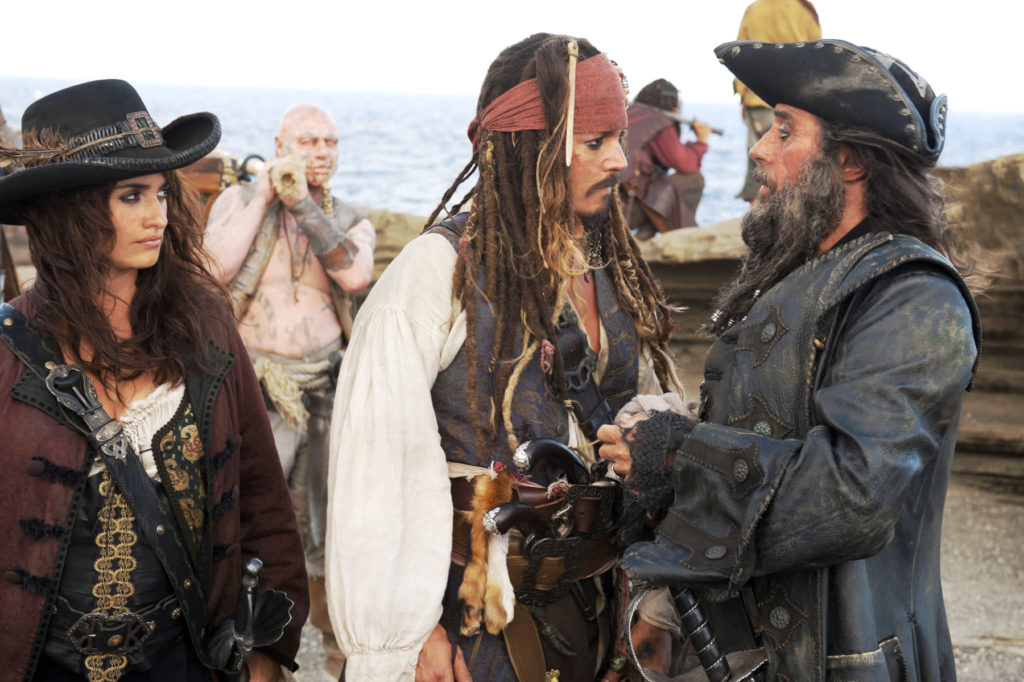March 7, 2017
Artist, News and Artists, Podcast Series
Creatives’ Corner Spotlight with Costumer April Krueger
This is the written version of our Podcast Series where we asked a handful of artists to:
- Describe your craft/art,
- Tell us about a project you are most proud of,
- Tell us about a project that challenged you the most and what you learned,
- Describe your creative process/ritual, and finally,
- What’s next for you?
Read what costumer April Krueger shared:
TAP: Describe your craft/art
AK: I am a costumer in the Major Motion Picture and Television Industry. I use clothing to transform actors into film and television characters.
TAP: Tell us about a project you are most proud of
AK: The project that I am most proud to have worked on as a costumer is “Pirates of the Caribbean.” I was in the industry less than a year when I received the call. I had the incredible opportunity to work with the talented Costume Designer, Penny Rose, with actor fittings. I learned so much about early eighteenth century period costumes. I learned about the significance of each costume piece, and how and why these pieces were worn. The main cast was fun to work with and incredibly friendly. To this day, I remain friends with members of the crew.
TAP: Tell us about a project that challenged you the most and what you learned
AK: The project that comes to mind is the film, “The Prestige.” It was a period piece starring Hugh Jackman, Christian Bale, and Michael Caine. There were a lot of costume changes for the actors, and we were shooting lots of nights. I was filming an 18-hour day, and understandably, everyone wanted to film the last shot and go home. Just as Director, Christopher Nolan started to film, I noticed that the actor’s 19th-century bow-tie had loosened. I immediately stopped the shot, ran onto the set, and adjusted the actor’s bow-tie. Why? Because, according to my written continuity notes and photographs of the previous shots of the same scene, the actor’s bow-tie was tightened. In this scene, if the loose bow-tie was cut against another scene where the bow-tie was fitted properly, the scene would have been utterly unusable and would have required re-shooting. The cost of re-shooting just one scene can cost a production company thousands of dollars. After that experience, I have learned always to take detailed continuity notes and be ready to solve an unsuspecting problem that can occur at any time during the filming process.
The cost of re-shooting just one scene can cost a production company thousands of dollars.
TAP: Describe your creative process/ritual, and finally,
AK: For me, the creative process is less abstract and more concrete and business-like. The pre-production phase includes script analysis, secondary research, and sourcing materials. My first task is to read the script and conduct a script analysis and breakdown. In the script analysis, is where I determine what each character will wear and make recommendations to the rest of the creative team. I also decide if we need more than one costume item and extra costumes for stunt doubles, or photo doubles. After my script read through, I will conduct secondary research. Typically, costume research includes studying books, pictures, and using databases to find the style of dress worn and materials for each character that is appropriate for the specified location and period of the story. Once the research is complete, I contact vendors and obtain price quotes for essential materials needed to manufacture the costumes such as fabric, buttons, etc. If we decide not to manufacture the costumes from scratch, they must be purchased or rented.
Another aspect of the pre-production phase involves fitting the costumes on the actor. I aid in costume fittings of cast members and determine if alterations or repairs are needed prior to shooting. After all of the costumes are fitted, altered or repaired, they are aged, laundered, ironed, and hung on hangers in the costume department.
On film day, before crew call, I will set the actor’s dressing rooms and dress the background artists before the first shooting scene of the day. As a costumer on the set, my responsibility is to maintain the “creative vision” on the actors and monitor the actors’ comfort during filming. I also track continuity by writing detailed costume notes, indicating what, when, where, and how the actors wear their costumes, i.e., (is a jacket worn or carried and is the collar worn open or closed). I photograph the actor in the costume and alter any costume right there on the set to ensure it is worn correctly on the actor during each scene. Often the director will want to add a shirt or accessory to the actor’s costume right before shooting. When this happens, I quickly make the costume change to avoid holding up camera. Once filming begins, I must always be present on the set, and I am responsible for the care and maintenance of the costumes until filming is completed for the day.
In addition to being an expert on current fashion trends and period clothing, costumers have to know how a color or print will translate on camera.
For example, avoid the color white because it will read on camera as the brightest object in the shot. Avoid red because it bleeds into other parts of the picture, and avoid prints because it will appear to vibrate on camera because of the camera’s scanning ability to create and generate new patterns. Avoid shiny, flashy and noisy jewelry because they will reflect the light and distract in the picture and the sound of the jewelry will be picked up by the actor’s microphone. On a production, time is money, and it is very important to keep the actors, producers, and the director happy.
TAP: What’s next for you?
AK: When I am not shooting in Los Angeles (or locally), I am actively using my education and my media experience to promote autism awareness. I am passionate about autism outreach to those families that are in underserved communities. Currently, I am involved in advocacy efforts with legislators to push for state funding of special needs schools in Maryland. I love working with other artists on projects that support social justice issues and issues that promote disability awareness.
Eventually, I want to bring my knowledge of fashion and style out of Hollywood and apply my talents to others.
Fashion is meaningful, and it is very intimate. Transcending fashion blogs and exploring what ideas people are communicating through what they wear is central to my future pursuits. Over the last 16 years, I have developed a unique talent for transforming people into the best looking version of themselves. In many cases, I have guided people in helping them find their own sense of style. In other cases, I have simply helped people enhance their own style without them feeling like they are sacrificing their personal identity. Leveraging this unique experience, I am considering starting an image consulting business.
 April Krueger is a costumer,and her projects include House of Cards, Pirates of the Caribbean I, II, and III, The Prestige, Catch Me if You Can, CSI: Crime Scene Investigation, Entertainment Tonight and Jimmy Kimmel Live! You can view April’s film and television credits here. April has also worked on Theatrical Stage Productions such as Marley, The Sound of Music, Motown and was a stylist for MTV as well as commercials. April was an assistant editor and a fashion stylist for print and digital publications. April is a member of the International Alliance of Theatrical Stage Employees (IATSE) in Los Angeles – Costumer’s Local 705 and Local 487 in the Mid-Atlantic region that covers Baltimore, Virginia, Delaware, and Washington, DC. She holds a Master of Arts in Communication from The Johns Hopkins University and a certificate in Fashion Design, Marketing and Merchandising from Cité Internationale Universitaire de Paris. Connect with her on the web and via Twitter @Amkru.
April Krueger is a costumer,and her projects include House of Cards, Pirates of the Caribbean I, II, and III, The Prestige, Catch Me if You Can, CSI: Crime Scene Investigation, Entertainment Tonight and Jimmy Kimmel Live! You can view April’s film and television credits here. April has also worked on Theatrical Stage Productions such as Marley, The Sound of Music, Motown and was a stylist for MTV as well as commercials. April was an assistant editor and a fashion stylist for print and digital publications. April is a member of the International Alliance of Theatrical Stage Employees (IATSE) in Los Angeles – Costumer’s Local 705 and Local 487 in the Mid-Atlantic region that covers Baltimore, Virginia, Delaware, and Washington, DC. She holds a Master of Arts in Communication from The Johns Hopkins University and a certificate in Fashion Design, Marketing and Merchandising from Cité Internationale Universitaire de Paris. Connect with her on the web and via Twitter @Amkru.
Tags: "autism awareness", "Colors to Avoid on Set", "continuity Notes", "Costume Designer, "Personal branding", "Pirates of the Caribbean", "The Prestige", "what does a costumer do?", April Krueger, Cité Internationale Universitaire de Paris, costumer, Costumer's Local 487, Costumer's Local 705, Creative Process, Hollywood, International Alliance of Theatrical Stage Employees, Los Angeles, Major Motion Picture and Television Industry, MD, Penny Rose"





 Follow
Follow